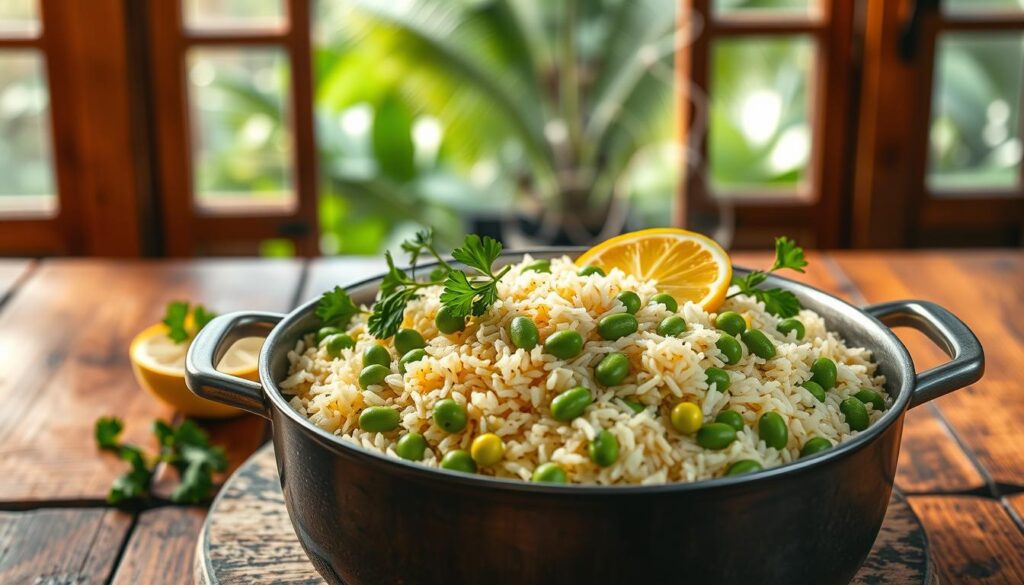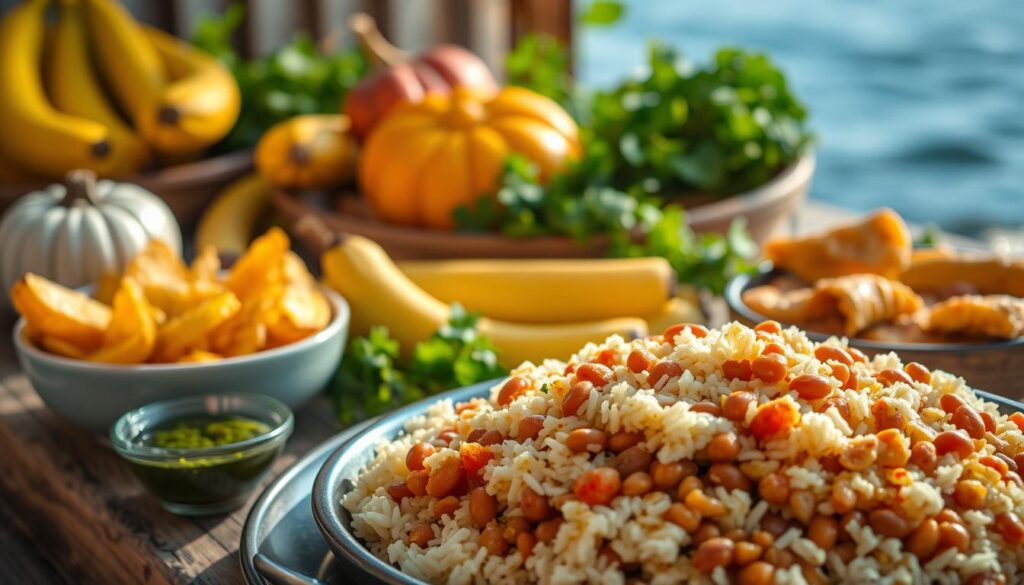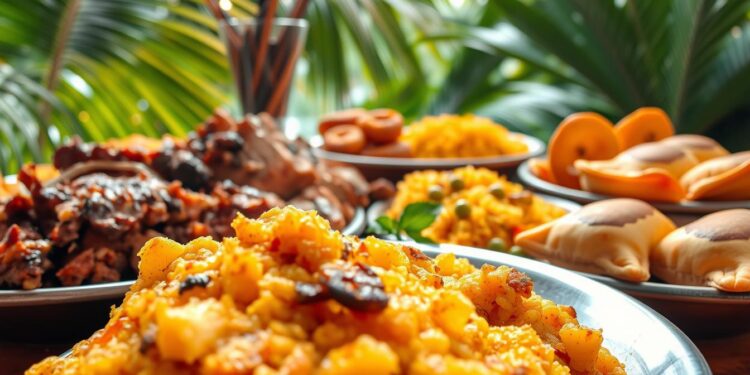Imagine enjoying a meal filled with flavors that tell the story of a vibrant island. You’re about to start a journey through Puerto Rican cuisine. It’s a mix of Spanish, African, and Taíno tastes.
This special cooking style, known as cocina criolla, shows the island’s varied culture and location. As you dive into island dishes, you’ll find a mix of tastes that will make you crave more. Puerto Rico food
Table of Contents
Key Takeaways
- Puerto Rican cuisine is a blend of Spanish, African, and Taíno influences.
- The island’s history and cultural heritage shape its culinary identity.
- Cocina criolla is a reflection of the island’s diverse cultural background.
- Puerto Rican cuisine offers a unique and flavorful dining experience.
- Essential island dishes showcase the island’s rich culinary heritage.
The Rich Heritage of Puerto Rico Cuisine
The island’s food culture is a mix of Spanish, African, and Taíno traditions. This blend creates a unique and tasty cuisine that defines Puerto Rico.
Spanish, African, and Taíno Influences
Puerto Rico food shows the island’s rich cultural mix. The Spanish influence is seen in olive oil, garlic, and pork, brought by Spanish settlers. African traditions added new ingredients and ways to cook, like plantains and yuca. The Taíno people, the island’s first inhabitants, contributed with their farming skills and native foods like corn, beans, and squash.
The Evolution of Island Flavors
These different influences have merged over time, creating a unique culinary identity. The mix of Spanish, African, and Taíno tastes has led to dishes like mofongo, arroz con gandules, and lechón asado. Exploring island flavors and traditional cooking methods lets you truly experience Puerto Rican cuisine.
Understanding Puerto Rico Food: A Culinary Overview
To get a grasp on Puerto Rico food, you must look at its regional flavors and the importance of family and celebrations. Puerto Rican cuisine is a lively mix of the island’s culture, shaped by its past and geography.
Regional Variations Across the Island
Puerto Rico food scene changes a lot from one region to another. The island’s varied landscapes, from beaches to mountains, affect the food. Coastal areas are known for seafood, while mountainsides offer stews and root veggies.
The Role of Family and Celebration
Family and celebrations are key in Puerto Rican cuisine. Food is at the heart of family events and celebrations, bringing everyone together.
Holiday Food Traditions
Puerto Rico holiday foods are a big deal. Traditional dishes are made during holidays, passed down through generations. They show the value of food in celebrating.
Everyday Meals vs. Special Occasions
Everyday meals in Puerto Rico are simple and cozy. But, on special days, the food gets fancier. This highlights the island’s rich food diversity.
Essential Ingredients for Your Puerto Rican Kitchen
A well-stocked Puerto Rican kitchen needs a few key ingredients. These add depth and authenticity to dishes. You’ll need to know about staple ingredients and seasonings to create rich flavors.
Sofrito: How to Make the Aromatic Base
Sofrito is key in many Puerto Rican recipes. It’s the aromatic base that adds depth to dishes. To make it, blend culantro, garlic, peppers, and more into a flavorful sauce.
As “Sofrito is the soul of Puerto Rican cooking”, getting it right is crucial.
Adobo and Sazón: Creating Signature Seasonings
Adobo and sazón are essential in Puerto Rican cooking. Adobo is a spice blend of garlic, oregano, and salt. It’s used to marinate meats and add flavor.
Sazón adds color and flavor, with ingredients like annatto, coriander, and cumin. Knowing how to use these seasonings is key for authentic Puerto Rican dishes.
Stocking Your Pantry with Island Staples
To cook Puerto Rican cuisine, stock your pantry with island staples. Rice, beans, and root vegetables like yuca and plantains are essential. These ingredients are the backbone of many dishes, including main courses, sides, and desserts.
Having these staples ready lets you create a variety of traditional Puerto Rican meals.
Mastering Traditional Cooking Techniques
The art of Puerto Rican cooking is rooted in traditional techniques. These include slow cooking, frying, and grilling. These methods have been passed down through generations, making authentic Puerto Rican dishes possible.
Slow Cooking Methods for Tender Results
Slow cooking is key in Puerto Rican cuisine. It makes tough cuts of meat tender and flavorful. Techniques like braising and stewing are used for dishes like carne guisada and pollo guisado.
To get tender results, cook the meat at a low temperature for a long time.
Perfecting Frying and Grilling Practices
Frying and grilling are also crucial in Puerto Rican cooking. Frying makes tostones and empanadas crispy. Grilling adds a smoky flavor to meats like lechón asado.
Getting the right oil temperature and grill heat is important for perfect texture and flavor.
Equipment You’ll Need
To cook traditional Puerto Rican dishes, you’ll need various pots, pans, and utensils. A large caldero is key for cooking rice dishes like arroz con gandules. A is also essential. Having the right equipment greatly improves your cooking quality.
How to Make Mofongo: The Iconic Dish
Want to explore Puerto Rican cooking? Making mofongo is a must. It’s a dish of fried green plantains mashed with garlic and other ingredients.
Selecting and Preparing Green Plantains
Choosing the right green plantains is key for great mofongo. Look for firm, green ones without any ripening signs. Peel them by cutting off both ends and removing the skin. Cut them into 1-inch rounds.
Step-by-Step Mashing and Seasoning
To make mofongo, fry the plantain rounds until golden. Then, mash them with garlic, salt, and oil in a pilón or large mortar. This makes a cohesive, slightly crispy mix.
Creating Delicious Fillings and Toppings
Mofongo can be filled with many things, from seafood to meat.
Seafood Variations
Try filling it with shrimp or crab meat in garlic butter for a seafood twist.
Meat-Based Options
Or, fill it with slow-cooked pork or chicken for a hearty meal.
| Filling/Topping | Description | Recommended For |
|---|---|---|
| Shrimp | Sautéed in garlic butter | Seafood lovers |
| Pork | Slow-cooked in a tomato-based sauce | Meat enthusiasts |
| Crab Meat | Lightly seasoned with herbs | Those seeking a lighter option |
Arroz con Gandules: Cooking the National Dish

Arroz con gandules is Puerto Rico’s national dish. It’s a mix of rice, gandules, and sofrito. This dish is loved at family events, showing the island’s culture and food traditions.
Preparing the Perfect Sofrito Base
The sofrito base is key to a great arroz con gandules. Sofrito is made from sautéed garlic, onions, bell peppers, and cilantro. Chop these finely and cook in oil until soft and fragrant. This makes the dish’s unique flavor.
Rice-to-Liquid Ratio Secrets
Getting the rice-to-liquid ratio right is important. Use a 1:2 ratio of rice to liquid. This liquid mix includes broth, gandules, and their cooking liquid. It adds depth to the dish. The right ratio ensures the rice is just right—neither too dry nor too wet.
Troubleshooting Common Issues
Cooking arroz con gandules can be tricky. Two big problems are mushy rice and not getting the perfect pegao, or crispy bottom.
Preventing Mushy Rice
To stop rice from getting mushy, watch the heat and don’t overcook. Choose medium-grain rice for the best texture. Also, don’t stir the rice too much to keep it from becoming mushy.
Achieving the Perfect Pegao
The pegao, or crispy bottom, is a must for arroz con gandules. Cook the rice over low heat for a long time. This lets the bottom layer get crispy. You need patience and a heavy pot to cook evenly.
- Use medium-grain rice for better texture.
- Don’t over-stir the rice during cooking.
- Cook over low heat to achieve the perfect pegao.
Lechón Asado: Your Guide to Roast Pork
Puerto Rico’s beloved lechón asado is more than a meal; it’s an experience. This traditional roast pork dish is marinated, roasted, and served with flair. It’s a showstopper for any gathering.
Marinating Techniques for Maximum Flavor
The key to a delicious lechón asado lies in its marinade. To achieve maximum flavor, combine adobo, sazón, and garlic. This creates a marinade that tenderizes the pork and infuses it with rich, complex flavors. Let the pork marinate for several hours or overnight to allow the flavors to penetrate deeply.
Roasting Methods for Home Cooks
Roasting lechón asado requires patience and attention to detail. For home cooks, using a slow-cooking method is ideal. You can roast the pork in the oven or on a grill, ensuring it’s cooked at a low temperature for several hours until it reaches tender perfection. The slow-cooking process allows the pork to absorb the flavors of the marinade fully.
| Roasting Method | Temperature | Cooking Time |
|---|---|---|
| Oven Roasting | 325°F (165°C) | 3-4 hours |
| Grill Roasting | Low heat | 4-5 hours |
Carving and Serving Your Masterpiece
Once your lechón asado is cooked, the final step is carving and serving it with flair. Use a sharp knife to carve the pork into thin slices. Serve it with your choice of sides, such as arroz con gandules or tostones. The presentation is key to making this dish a true crowd-pleaser.
Traditional Puerto Rico Food for Special Occasions
Puerto Rican special occasions are a time to indulge in the island’s most beloved and traditional recipes. These dishes not only satisfy the palate but also bring families and friends together, creating lasting memories.
Pasteles: Wrapping and Cooking the Holiday Favorite
Pasteles are a staple during Puerto Rican holidays, particularly Christmas. They consist of a mixture of root vegetables and pork, wrapped in banana leaves. Making pasteles is a labor of love, often involving the entire family in the preparation process.
The process of making pasteles begins with preparing the dough, known as “masa,” from ingredients like green bananas, plantains, and yuca. The filling, typically made with pork, beef, or chicken, is then wrapped in the dough and further enveloped in banana leaves. This traditional dish is steamed to perfection, resulting in a flavorful and comforting meal.
Pernil: Slow-Roasted Pork Shoulder
Pernil, or slow-roasted pork shoulder, is another dish that takes center stage during Puerto Rican celebrations. The pork is marinated in a mixture of garlic, oregano, and citrus juices before being slow-roasted to achieve tender, fall-apart meat.
The key to a delicious pernil lies in its marinade and the slow roasting process. The pork is typically scored to allow the marinade to penetrate deeper into the meat, enhancing its flavor. Roasting it at a low temperature for several hours ensures that the meat is not only flavorful but also incredibly tender.
Coquito: Crafting the Coconut Holiday Beverage
No Puerto Rican celebration is complete without coquito, a creamy coconut beverage that’s reminiscent of eggnog. Coquito is made with coconut milk, sweetened condensed milk, rum, and spices, creating a rich and indulgent drink.
To make coquito, you combine coconut milk, sweetened condensed milk, rum (optional), vanilla extract, and a pinch of cinnamon in a blender. The mixture is blended until smooth and then chilled before serving. This refreshing beverage is perfect for sipping during the holiday season.
| Dish | Main Ingredients | Occasion |
|---|---|---|
| Pasteles | Root vegetables, pork, banana leaves | Christmas, Family Gatherings |
| Pernil | Pork shoulder, garlic, oregano, citrus juices | Holidays, Special Celebrations |
| Coquito | Coconut milk, sweetened condensed milk, rum | Holiday Season |
Quick and Easy Puerto Rican Sides

Explore the tastes of Puerto Rico with these easy yet tasty side dishes. They go great with any meal. Puerto Rico food is famous for its bold flavors and big portions, and the sides are no different.
Tostones: Double-Fried Plantain Rounds
Tostones are a key part of Puerto Rico food. They’re made from green plantains, sliced, fried until crispy, and then flattened. You’ll need green plantains, oil, and salt to make them.
To make tostones, fry the plantain slices until they’re golden. Then, flatten them and fry them again until they’re crispy. Serve them with your favorite dishes for a tasty crunch.
Maduros: Sweet Plantain Preparation
Maduros, or sweet plantains, are a favorite side in Puerto Rico. They’re made with ripe plantains, which are sweeter and softer than green ones. To make maduros, slice ripe plantains, fry them in oil until caramelized, and season with salt.
The result is a sweet and savory side dish that goes well with many main courses.
Arroz Blanco and Habichuelas Guisadas
Arroz blanco (white rice) and habichuelas guisadas (stewed beans) are key parts of Puerto Rican meals. To make arroz blanco, sauté rice with garlic and then simmer it in broth until it’s tender. Habichuelas guisadas are made by stewing beans with sofrito, a mix of sautéed aromatics, and sometimes meat or bacon for extra flavor.
“Arroz blanco and habichuelas guisadas are the backbone of Puerto Rican cuisine, providing a comforting and satisfying base for meals.”
Together, these dishes make a comforting and traditional Puerto Rican side. They go well with many main courses.
Asopao and Soups: One-Pot Comfort Foods
In Puerto Rican cooking, asopao is a true comfort food. It’s a traditional soup that combines rich flavors. These flavors warm both the heart and the home.
Chicken Asopao: Step-by-Step Instructions
To make chicken asopao, start by browning chicken pieces in olive oil. Then, add sautéed vegetables, rice, and chicken broth. Let it simmer slowly until the rice is tender and the flavors mix well.
Seafood Variations to Try
Chicken asopao is classic, but seafood variations are tasty too. Use shrimp, mussels, and fish instead of chicken. Adjust cooking time so seafood is fully cooked.
Achieving the Perfect Consistency
The right consistency is key in asopao. It should be thick and creamy, not too watery. Adjust rice to liquid ratio or simmer longer to get it right. Try different approaches to find your favorite.
Puerto Rican Desserts: Sweet Endings
Explore the sweet side of Puerto Rico, where desserts tell stories. These treats mix Spanish, African, and Taíno flavors. They are both traditional and new.
Tembleque: Coconut Pudding Perfection
Tembleque is a coconut pudding loved in Puerto Rico. It’s made with coconut milk, sugar, and cornstarch. Vanilla and cinnamon add a warm taste.
It’s great for vegans because it’s dairy-free. “Tembleque shows Puerto Rico’s cuisine spirit,” says a food critic. It’s simple yet full of flavor and history.
Flan: Mastering the Caramel Custard
Flan is a caramel custard loved in Puerto Rico. It’s made with eggs, sugar, and milk, baked in a caramel dish. This makes it creamy with a sweet caramel sauce.
Getting flan right takes patience. But the smooth texture and caramel sauce are worth it. Cooking the caramel and baking the custard just right is key.
Fruit-Based Treats and Quick Sweets
Puerto Rican desserts also include fruit treats and quick sweets. Coconut macaroons and fruit salads are perfect for hot days or a light snack. They use fresh fruits like mango and pineapple.
These desserts are tasty and pretty. You can mix fruits and flavors to make your own unique desserts.
Looking for a creamy pudding, caramel custard, or fresh fruit dessert? Puerto Rican sweets have it all. Their rich flavors and diverse tastes will satisfy any sweet craving.
Conclusion: Bringing Puerto Rican Flavors Into Your Home
Bringing Puerto Rican flavors into your home cooking is a great way to explore the island’s rich culinary heritage. By incorporating traditional Puerto Rican dishes and ingredients into your meals, you can add flavor and excitement to your everyday cooking.
Cooking Puerto Rican cuisine at home allows you to experiment with new ingredients and techniques, such as making sofrito or cooking with plantains. This not only enhances your cooking skills but also introduces you to the vibrant flavors of Puerto Rico.
Puerto Rican cuisine is perfect for special occasions or casual gatherings, as it offers a variety of dishes that can cater to different tastes and preferences. As you continue to explore and master these recipes, you’ll find that Puerto Rican flavors can elevate your home cooking and create memorable dining experiences.
Start your culinary journey today and discover the joy of cooking with Puerto Rican cuisine. With its rich flavors and hearty dishes, you’ll be sure to impress your family and friends with your newfound cooking skills.
FAQ
What is Puerto Rican cuisine, and what influences have shaped it?
What are some essential ingredients for making authentic Puerto Rican dishes?
How do you make mofongo, a beloved Puerto Rican dish?
What is the significance of arroz con gandules in Puerto Rican cuisine?
How do you achieve the perfect consistency when making asopao, a traditional Puerto Rican soup?
What are some popular Puerto Rican desserts?
What are some traditional Puerto Rican dishes for special occasions?
How can you incorporate Puerto Rican flavors into your home cooking?
external link: celebritycruises


